|
 людан_купол
Пятница, 27 Января 2023 г. 13:50 (ссылка) людан_купол
Пятница, 27 Января 2023 г. 13:50 (ссылка)
РОССЕТТИ 1856 - 1857.
1856 - 1857.
1856
Dante's dream at the Time of the Death of Beatrice. Walker Art gallery - Liverpool, UK
1857
1.A Christmas Carol Watercolour and gouache on paper. Fogg Museum of Art, Harvard University, Cambridge, MA, USA.
2.Before the Battle (1857-58)
3.The Blue Closet Watercolour on paper. Tate Gallery, London, UK.
4.The Damsel of the Sanct Grael
5.The Lady of Shalott (from the Moxon Tennyson)
6.St. Catherine 1857 Oil on canvas. Tate Gallery, London, UK
8.The Tune of Seven Towers Watercolour on paper. Tate Gallery, London, UK
9.The Wedding of St. George and the Princess Sabra Watercolour on paper. Tate Gallery, London, UK.
10. Мария Магдалина.
11.Рождественский гимн. 1857
Christmas Carol
12.Сэр Галахард в разрушенной часовне. Sir Galahad at the ruined Chapel

13. Эскиз Гиневры для "Сэр Ланселот в королевской комнате"
Study of Guinevere for "Sir Lancelot in the Queen's Chamber"
14. Сэр Тристам и Прекрасная Изольда пьющие любовное зелье.
Sir Tristram and La Bella Yseult Drinking the Love Portion.
Пять его иллюстраций включены в 1857 Moxon Tennyson. В июле выставил восемь работ на выставке прерафаэлитов на Russell Place. До ноября работал над фресками Oxford Union
В 1857 году в Оксфорде он влюбился в семнадцатилетнюю Джейн Бёрден, но в 1859 году она выходит замуж за Морриса. Хотя любовь к Лиззи охладела, но его отношения к Сиддал и Бёрден отвечают самым строгим стандартам того времени.
Антонио Фредерик Огастас Сэндс (англ. Antonio Frederic Augustus Sands) получил известность благодаря карикатуре на картину Джона Эверетта Милле «Сэр Изюмбрас» в 1857 году. Художник вместо лошади поместил осла, помеченного буквами «J. R., Oxon» (J. R. — Джон Рёскин, Oxon — Оксфорд), сверху сидел Милле в рыцарских доспехах, а двое маленьких детей спереди и сзади изображали товарищей Милле по Братству прерафаэлитов Данте Габриэля Россетти и Уильяма Холмана Ханта. Пародия называлась «Ночной кошмар», «A Nightmare».
Как ни странно, Сэндис и Россетти стали близкими друзьями, Сэндис одно время даже жил в доме Россетти в Чейни-Вок (Челси). Многие картины Сэндиса написаны под сильным влиянием Россетти, впоследствии обвинявшего его в плагиате.
В ноябре 1856 года Россетти пригласил Томаса Плинта в студию Форда Мэдокса Брауна посмотреть "Труд" картину он хотел купить, но умер.
A Christmas Carol
1857-1858
Medium: watercolour
Dimensions: 13 1/4 x 11 1/2
Signature: monogram
Date on Image: Xmas 1857-8
Note: Monogram and date are inscribed at upper left.
The Wedding of St. George and the Princess Sabra.
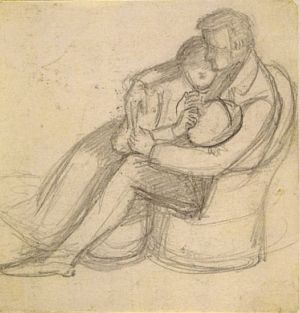 Пара на этом наброске расслаблена и фигуры несколько бесформенны, в то время как в окончательном варианте фигура Георгия угловата и определённа. Пара на этом наброске расслаблена и фигуры несколько бесформенны, в то время как в окончательном варианте фигура Георгия угловата и определённа.
ДАНТЕ ГАБРИЭЛА РОССЕТТИ. СВАДЬБА СВЯТОГО ГЕОРГИЯ И ПРИНЦЕССЫ САБРЫ
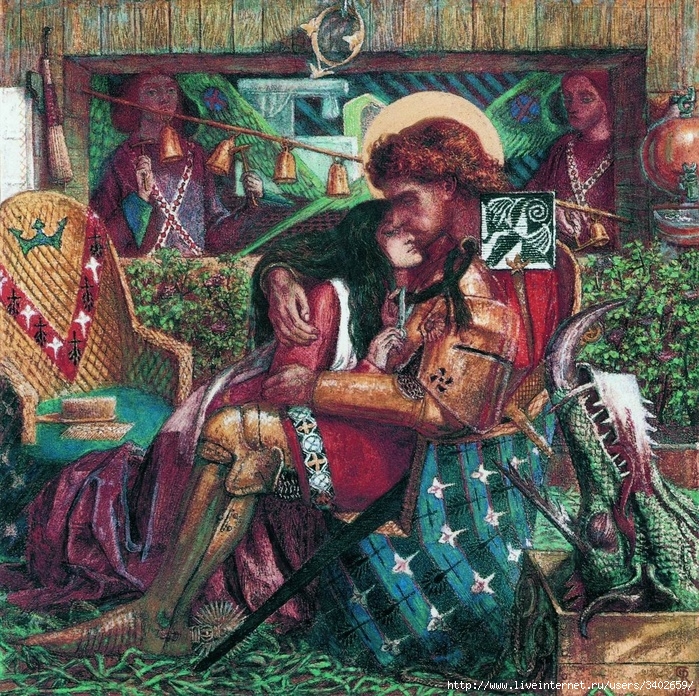
Россетти работал над акварелью в Оксфорде, где жил вместе с Моррисом и Бёрн-Джонсом.
Water color painted in 1857, and exhibited in 1858 at Liverpool Academy. Owned by George Rae. St. George appeared in Syria just in time to rescue Princess Sabra, daughter of the King of Syria, from being sacrificed to the dragon. St. George is restling from having slain the dragon, while the Princess, now wholly his, leans on his breast, cutting off a long dark lock of hair to bind upon his helmet. One of Rossetti's early water colors beautifully executed. The dragon's head in the box, the wealth of detail and pattern of the design, and the rich, golden coloring are striking.
На плече у Георгия ailette.
The ailette (French language for little wing) was a component of thirteenth century knightly armour. Usually made of plate or parchment, ailettes were thick, quadrangular pieces of leather or wood that attached to the shoulders by means of silk or leather cord. Ailettes were usually flat and nearly rectangular in shape, and usually decorated with heraldic designs.
Ailettes made brief appearances between 1290 and 1325 before giving way to more protective joint plates that covered the joint gap in the shoulders.
The purpose of ailettes is a matter of disagreement amongst scholars. Some claim that they enhanced protection to the neck, while othersargue that they were used primarily for decorative and heraldic reasons.
Источник сюжета, возможно, баллада из T. Percy, Reliques of Ancient English Poetry.
Дракон убит, принцесса Сабра причёсывается и повязывает локон на шею Георгию, на заднем плане брачная постель. В это время и Россетти и его друзья подумывали о женитьбе.
St. George and the Princess Sabra was painted by Dante Gabriel Rossetti in 1862. This was the last work that his wife, Lizzie Siddal, posed for before her death. Для этой акварели позировала Сиддал, позже, обратившись к этой теме Россетти выбрал моделью Джейн Бёрден.
The Wedding of St. George and the Princess Sabra
Женитьба Святого Георгия на принцессе Сабра.
Хотя картина написана в 1862 году, но по теме решил поместить здесь.
Watercolour on paper
Having killed the dragon, St George washes the blood from his hands in his upturned helmet. He watches through the window as a crowd carries the dragon's head in triumph. Typically, Rossetti makes the public celebration subordinate to the interaction between St George and Princess Sabra whose life he saved. In an intimate and disturbing scene, she kneels kissing his bloodied hands.
The Blue Closet
1856-1857
Model: Elizabeth Siddal
Note: Siddal sat for the queen on the right.
The blue tiles, visible at the back wall and the floor, argue that the entire “closet” is indeed enclosed in their blue; and the pair of blue emblems on the bells and lute define another symmetry.
По мнению Элизабет Преттджон первоисточником для Синей комнаты послужила картина "Четыре музицирующих ангела" Тадео Гадди. Россетти мог видеть её в 1857 году в коллекции Крайст-Чёрч в Оксфорде.
The Tune of Seven Towers
Мелодия семи башен 1857
The Tune of Seven Towers
Watercolour on paper. 1857 Tate Gallery, London, UK
Начата весной 1857. Композиция развита из рисунка 1853 г "Michael Scott's Wooing". Тема загадочна и, возможно, автобиографична, в это время Россетти был обеспокоен тяжелой болезнью Сиддал. (позировала для женщины в красном, играющей на музыкальном инструменте). Слева на вымпеле вышиты те самые семь башен. Тема, возможно, заимствована из сборника средневековых песен, изданных в то время или из любимого Моррисом средневекового рассказа Aucassin and Nicolete. Голубь в клетке у Россетти служил эмблемой Сиддал.
“Young woman holding an open book, having her hair dressed by an attendant, is seated by a man; both are facing to the left looking towards the figure of Love standing beneath a tree, playing on an instrument. A child sits on the floor to the right of the chair; another figure in the background with head bowed”
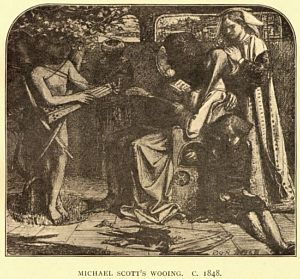
depicts the medieval Scottish magician and astronomer Michael Scott placing a ring on the finger of a young girl.
Michael Scott's Wooing стихотворение Россетти.
ROSE-SHEATHED beside the rosebud tongue
Lurks the young adder's tooth;
Milk-mild from new-born hemlock-bluth
The earliest drops are wrung:
And sweet the flower of his first youth
When Michael Scott was young.
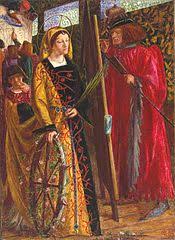 Святая Катерина. St. Catherine 1857 единственная законченная картина маслом между 1850 и 1859 годами. Святая Катерина. St. Catherine 1857 единственная законченная картина маслом между 1850 и 1859 годами.
На картине Россетти изобразил богатую даму, которая предназначая картину в дар церкви, хочет, чтобы святая была срисована с неё. Картина была заказана Рёскиным, который позже отказался от неё, назвав несуразицей. Модель - Элизабет Сиддал.

Сэр Галахард в разрушенной часовне.
Sir Galahad at the ruined Chapel
Watercolour and bodycolour with areas of gum arabic on paper.
Width: 345 mm
Height: 290 mm
В 1855-56 годах Россетти исполнил пять иллюстраций для издания Теннисона у Мохона в 1857 году. Три из них он потом повторил как акварели, это одна из них. Тема заимствована из "Сэра Галахарда" Теннисона, в свою очередь вдохновлённого Мэлори. Данная композиция носит сильное влияние Берн-Джонса.
In 1855-56 Rossetti made five designs for illustrations to Moxon's edition of Tennyson, published in 1857. Three of these designs of which this is one, he later carried out in watercolour. The subject is dervied from Tennyson's 'Sir Galahad', inspired by Malory. The four other subjects were 'The Lady of Shalott', 'Mariana in the South' and two from 'The Palace of Art'. This composition shows the strong influence of Burne-Jones.
Эта акварель иллюстрирует "Сэра Галахарда" Теннисона: Меж влажных стволов мерцание, слышу звуки гимна, затем подъезжаю к тайному святилищу, слышу голос, но никого нет, скамьи пусты, двери распахнуты, тонкие свечи ярко горят. Снежным блеском сверкает алтарный покров, искрятся серебряные сосуды... Переведу потом.
This watercolour illustrates Tennyson's Sir Galahad -'Between dank stems the forest glows,
I hear a noise of hymns:
Then by some secret shrine I ride;
I hear a voice, but none are there;
The stalls are void, the doors are wide,
The tapers burning fair.
Fair gleams the snowy altar-cloth,
The silver vessels sparkle clean,
The shrill bell rings, the censer swings,
And solemn chants resound between.'
Sir Galahad and an Angel
Alternately titled: Alma Mater and Mr. Woodward
1857
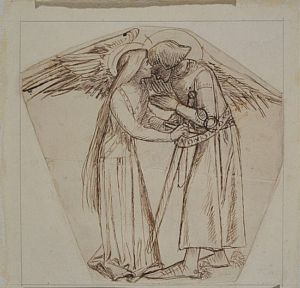
Sir Galahad, Sir Bors and Sir Percival Receiving the Sanc Grael.
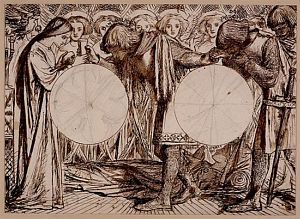
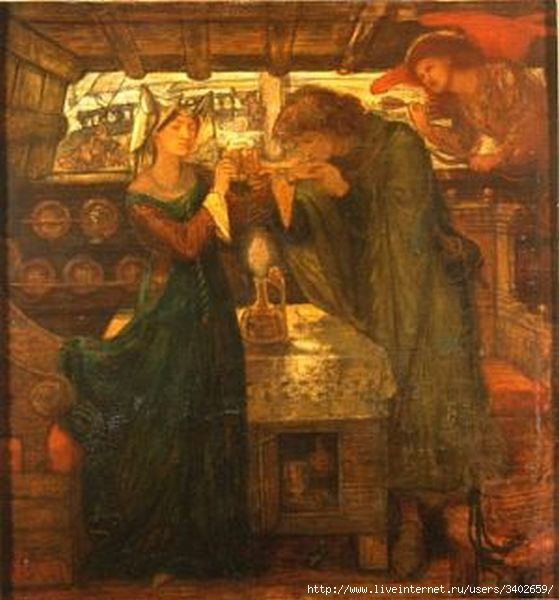
Сэр Тристам и Прекрасная Изольда пьющие любовное зелье.
Sir Tristram and La Bella Yseult Drinking the Love Portion.
The Lady of Shalott 1856-57 (circa)
The Lady of Shallott, 1857
Wood engraving, 35/16 x 31/16 in.
Victoria and Albert Museum, London
Иллюстрация к поэме Теннисона. Леди из Шалотта - магическое существо, которое живёт в замке на острове выше по течению от Артуровского Камелота. Её занятие состоит в том, что она смотрит в зеркало изь окна своего замка и вышивает то, что видит на гобелене. Ей запрещено заклятьем смотреть на внешний мир прямо. Фермеры, живущие рядом с островом слышат её пение и знают, кто она, но никогда не видели её. Дама видит простых людей, влюблённые пары, рыцарей, отражёнными в её зеркале. Однажды она видит Сэра Ланселота в одиночестве едущего верхом. И хотя она знает, что это запрещено, выглядывает из окна и смотрит на него. Зеркало разлетается на куски, вышивку уносит ветер и Лэди начинает чувствовать смертоносное действие проклятья. Разражается буря. Леди покидает замок, находит лодку, пишет на ней своё имя, плывёт по течению и поёт прощальную песню. Лодку прибивает к Камелоту, жители находят лодку и тело, догадываются кто это и грустят. Ланселот молится о милосердии божьем к её заблудшей душе.
The Lady of Shalott is a magical being who lives alone on an island upstream from King Arthur's Camelot. Her business is to look at the world outside her castle window in a mirror, and to weave what she sees into a tapestry. She is forbidden by the magic to look at the outside world directly. The farmers who live near her island hear her singing and know who she is, but never see her.
The Lady sees ordinary people, loving couples, and knights in pairs reflected in her mirror. One day, she sees the reflection of Sir Lancelot riding alone. Although she knows that it is forbidden, she looks out the window at him. The mirror shatters, the tapestry flies off on the wind, and the Lady feels the power of her curse.
An autumn storm suddenly arises. The lady leaves her castle, finds a boat, writes her name on it, gets into the boat, sets it adrift, and sings her death song as she drifts down the river to Camelot. The locals find the boat and the body, realize who she is, and are saddened. Lancelot prays that God will have mercy on her soul.
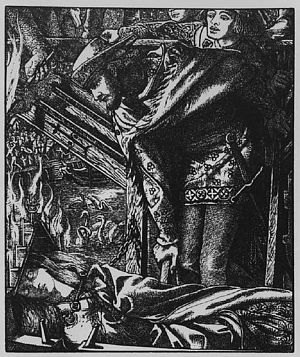 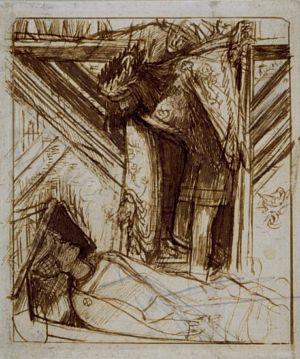
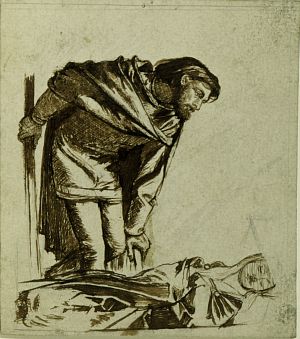
'The Lady of Shalott', Dante Gabriel Rossetti
This engraving was just one of the illustrations to tennyson's poems provided by the Pre-Raphaelite cicle for an edition published by Moxon. 1857.Rossetti's illustrations for tennyson astonished his collegues and had a far- reaching impact on a wider audieence. The project as a hole helped to define the Pre-Raphaelite Brotherhood, creating the impression of a coherent movement at the very momentwhen the artists were going their serarate ways.
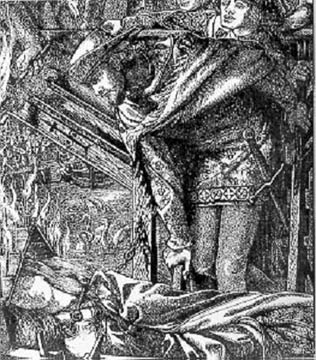 Illustration from 'Poems by Alfred Tennyson', published by Moxon Wood engraving by Dalziel brothers after Rossetti's design, Illustration from 'Poems by Alfred Tennyson', published by Moxon Wood engraving by Dalziel brothers after Rossetti's design,
published 1857, 9.4 x 8cm, Stephen Calloway
Richly clad, Sir Launcelot leans over the Lady's body as it floats down the river in the barge, lit by flickering candles and a torch held by an unseen figure above. The contrast between the tiny figures of courtiers and the daring close-up of the principal figures adds to the mood of strangeness. The composition may have been suggested by a medieval manuscript illumination from the 14th century 'Lancelot du Lac' in the British Museum.
|
